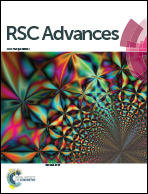Molecularly imprinted electrochemical sensor based on an electrode modified with an imprinted pyrrole film immobilized on a β-cyclodextrin/gold nanoparticles/graphene layer†
Abstract
A novel molecularly imprinted electrochemical sensor was constructed for the sensitive detection of quercetin (Qu) based on a glassy carbon electrode (GCE) modified with β-cyclodextrin (β-CD), gold nanoparticles (AuNPs) and graphene (GR). The molecularly imprinted polymers (MIPs), which were applied as the molecular recognition element, were prepared by electropolymerization using Qu as a template and pyrrole as a monomer. The fabrication conditions that affect the performance of the sensor, such as PH, pyrrole concentration, scan rate and scan cycles, were investigated. The sensor was characterized by cyclic voltammetry (CV), differential pulse voltammetry (DPV), electrochemical impedance spectroscopy (EIS) and scanning electron microscopy (SEM). Under the optimized conditions, the sensor offered an excellent response for Qu, the linear response range was 1.0 × 10−9 to 1.0 × 10−6 mol L−1 (R = 0.9998) with a detection limit of 1.0 × 10−10 mol L−1. Moreover, the proposed sensor possessed good selectivity and stability, providing a promising tool for practical applications.


 Please wait while we load your content...
Please wait while we load your content...